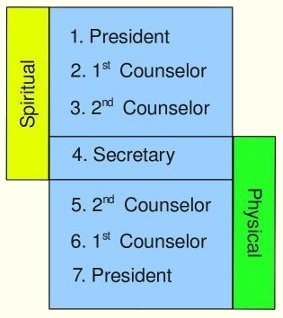
by John P. Pratt
10 Oct 2015, End Tabernacles (E), 13 Temple (SR), 1 Fulness (UV, M, UM)
©2015 by John P. Pratt. All rights Reserved.
| 1. Pattern of Seven |
| 1.1 Seven Chief Angels |
| 1.2 Constellation Shape |
| 1.3 Super Constellation |
| 2. Seven Constellations |
| 2.1 The Little Bear (Little Dipper) |
| 2.2 The Big Bear (Big Dipper) |
| 2.3 The Seven Sisters |
| 2.4 The Dolphin |
| 2.5 The Southern Fish |
| 2.6 The Infant Prince |
| 2.7 The Balance |
| 3. Conclusion |
| Notes |
In an earlier article, the Priesthood Pattern of Seven was introduced, which discussed a general pattern of seven which is exemplified by the roles of the seven chief angels.[1] After briefly reviewing those duties, this article introduces a kite-shaped star pattern which symbolizes those roles. It is then shown that there are seven constellations which when viewed on a map of the entire sky are found to be in that pattern. The name "super constellation" is proposed to describe a sky figure where each element is an entire constellation rather than a star. Moreover, each of those constituent constellations is in turn composed of seven principal stars arranged in that same kite pattern. Each of those seven constellations is then discussed with possible meanings proposed.
This discovery testifies that an almost incredible amount of order and time went into designing the constellations. Earlier articles have discussed how the Book of Enoch claims, contrary to popular belief that bored shepherds fancied they saw pictures in the stars, that an angel of God revealed the constellations to the prophet Enoch. Their purpose is apparently to testify both of the Savior and of His seven chief angels. The amazing order found in them which is discussed in this article provides compelling evidence that the constellations are not the result of whim, but contain many layers of deep religious knowledge.
Let us now review the Priesthood Pattern of Seven and suggest a star pattern to represent it.
 |
The last three men also serve as a presidency, with a president and two counselors. They are numbered such that the president is number 7, first counselor is number 6 and second counselor is number 5. This presidency shares the same scribe employed by the other group, who is number 4. Thus the seven represent two presidencies back-to-back with a shared secretary.
The seventh president also presides over all of the other six, which is the same as the pattern used for the seven presidents of the Seventy of the LDS Church (D&C 107:94). This latter presidency of four does not preside over different levels of spirituality, but rather over different physical aspects. These can be the physical areas where those presided over are located. It was proposed in that earlier article that in the case of the seven angels, the seventh angel, known as the archangel (D&C 88:112), presides over the entire earth. The first counselor presides over the eastern hemisphere and the second counselor over the western hemisphere.[2] The fourth member may preside over the translated city of Enoch and also functions as secretary for all seven. These duties of the general pattern are illustrated in Figure 1.
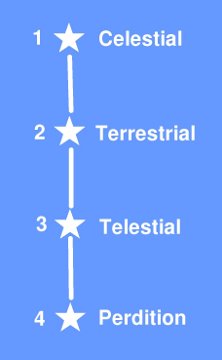 |
In Figure 1, the seven are represented in a simple list. If we only had one dimension to work with, a simple line of seven stars would not only suffice but it would be the only option. But the sky appears to look like the inside of a sphere. In one sense, the stars all appear to be at the same distance, as if attached to the inside of a "celestial sphere". Indeed, that is the name used by astronomers when they draw maps of the heavens. They can be projected down into a two dimensional map to draw figures.
Even using two dimensions, the first four presidents are probably best represented by a simple line of four stars. That is because they represent four levels of spirituality, and it appears that a simple line showing four levels could do the job nicely, as in Figure 2.
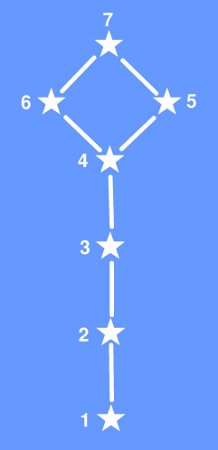 |
Of course, we do not expect to find a constellation that looks exactly like Figure 3 in the heavens, but we can note that there are several constellations which have four stars roughly in a square and then a string of three more stars coming from one corner. Of course the line can be curved. There are many constellations which have a curved string of stars that end in a roughly square figure. What led to this article was noticing there are about seven such constellations with stars in that shape. The idea came that there may indeed be a set of exactly seven such constellations that have special meaning.
This proposal is strengthened by the fact that in the Hebrew Calendar there is a pattern of seven sets of seven which is repeated at different levels. For example, the annual Feast of Firstfruits (Pentecost or the Feast of Weeks) follows the Hebrew equivalent of Easter by exactly seven weeks. That is seven sets of seven days each. Similarly, a jubilee is seven sets of sevens years each. Moreover, the constellations can be shown in a grid with each of seven angels being associated with seven constellations, for a total of 49. So there is strong precedent for the sacred use of seven sets of seven.
Before this article could be written it was necessary to have compelling evidence that seven constellations really were designed to be seen with seven principal stars in the proposed pattern and, if so, exactly which seven constellations are indicated. At least five were known without doubt because they only had seven stars and they were very nearly in the desired shape. But how could one be sure of all seven?
It was then discovered only this week that if one looks at a map of the entire sky, there are seven constellations which themselves are in the kite shape proposed for the Priesthood Pattern of Seven. The name "super constellation" was coined to described a sky figure formed by entire constellations rather than stars. In fact, this super constellation is almost exactly in the shape of the Little Bear, which is one of the most clearly indicated constellations of the group. That constellation is in the first position of the seven and it only contains exactly seven stars in the proposed shape.[3] Let us now look more closely at the great pattern which to me leaves no doubt about which are the correct seven constellations to consider.
In an earlier article, it was shown that one can actually map the heavens into a grid of 49 constellations in a square seven by seven.[4] That map is shown in Figure 4, with a square icon used to represent the location of one constellation in the sky. It is important to understand that this grid is not a rearrangement of the constellations but it is an actual approximate projection of the sky onto a square map. The super constellation is shown by the constellations with a gray background, outlined with a heavy black square.
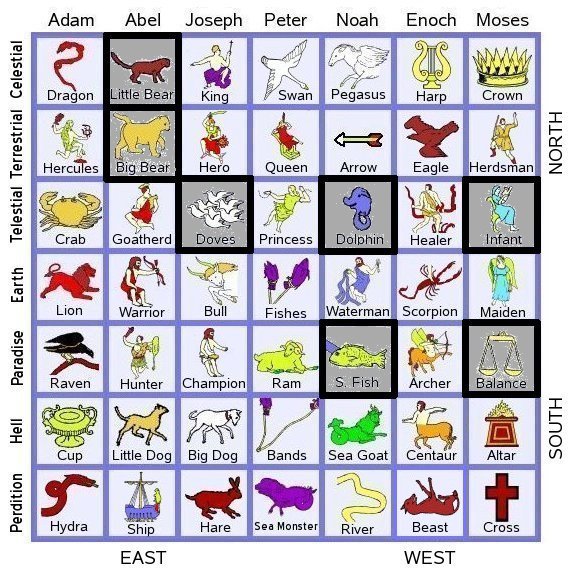 |
Each column of seven constellations is associated with one of the seven chief angels and each row with a different level of spirituality. Each one of the seven constellations is either feminine or a fish. Women often represent spirituality and can represent male priests or angels. The fish is often symbolic of a church. Thus, they all also fit the pattern that they may represent priesthood leaders or spiritual groups.
It is stunning that there are seven constellations which taken as a whole are in the kite pattern, with each having seven stars in that same pattern. Moreover, as we shall see, even the very positions in the entire map have deep symbolic meaning.
Figure 5 shows how the super constellation looks on a map of the constellations shown in the correct relative size to each other. It is seen that it wraps all the way around the sky so that the end nearly touches the beginning. That is, the Infant Prince is adjacent to the Big Bear. It encircles the entire heavens. It would have been very difficult to discover without the aid of the 7 x 7 grid map.
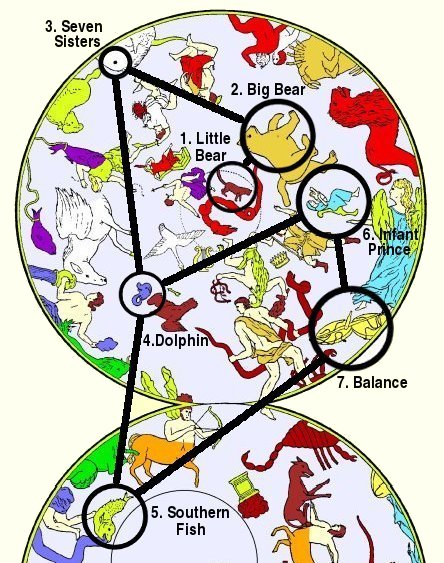 |
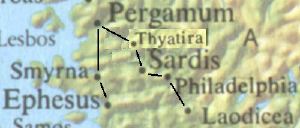 |
In the spirit of searching for meaning, note that these seven constellations include five female constellations and two fish. In the miracle Jesus performed beginning with the five loaves (baked by women?) and two fish (Mat. 14:17), was there any significance to the numbers five and two? It may be a big stretch of the imagination to connect these two disparate ideas, but it seemed worth mentioning. After all, the Savior found significance in how many baskets were left over (Mark 8:19)! It is difficult to plumb the depth of sacred symbolism. Let us now look at each of these seven constellations.
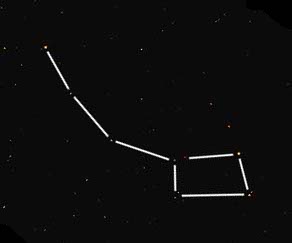 |
The star in the first slot of the seven stars in the Little Dipper, at the tip of the handle, is Polaris, the North Star. Although it doesn't show well in Figure 7, it is noticeably brighter than most of the other stars in the constellation. It is less than one degree from the true north point in the sky where the celestial sphere appears to rotate around daily. Of course, it is really the earth which is rotating, but that makes the sky look like it is turning.
It seems significant that Polaris is in the first (celestial spiritual level) slot in the constellation which is the first slot of the super constellation. It is the first of the first. That is the same position that the jubilee year is located in the set of 49 years. The jubilee is the 50th year, which puts it in the first slot because there are only 49 in the group.
Some of the ancient Greeks identified the Little Bear as representing Ida, one of the two nymphs who suckled the infant Zeus. They saw the Big Bear as Adrasteia who was the other one.
The ancient Arabs saw this constellation as a flock of grazing animals and called it "The Fold".[6] If it represents a church (like a flock of sheep), then it may represent the Church of the Firstborn, which is a celestial level group of the valiant followers of Jesus Christ (D&C 76:54, 88:4-5).
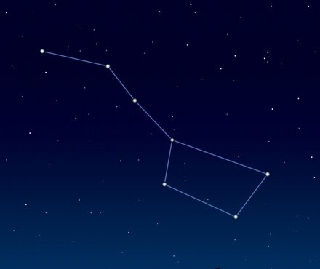 |
It may be important to note that in mythology, both the bears are female. One ancient Greek (Eratosthenes) identified the Big Bear as Callisto who was changed into a bear by Artemis as a punishment for breaking her vow of chastity. The importance would be that most female figures represent spiritual people or groups.
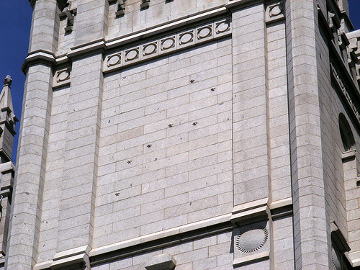 |
On the west wall of the great Salt Lake Temple, underneath the center spires, is a symbolic representation of the constellation of stars known as "The Dipper" with the pointers pointing to the north star, which was said by the architect of the temple to represent the great truth that through the priesthood of God the lost may find their way.[7]
This symbolism is precisely the same as that suggested by the scriptures. The apostle John was told that the seven stars in the hand of Christ represented the seven angels or servants of the seven churches which referred to their priesthood leaders (Rev. 1:20).[8] Thus, we see that a wide variety of sacred writings refer to seven stars as having been inspired and having deep meaning referring to the priesthood.
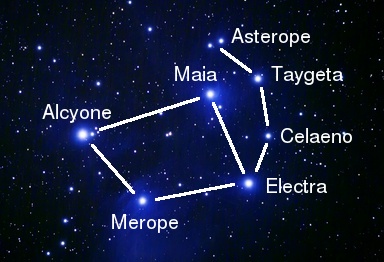 |
It has a clearly visible rectangle formed by four of its brightest stars. Novice star gazers sometimes mistakenly think this beautiful little cluster is the Little Dipper. As shown in Figure 10, the other three stars form a little string which can be thought of as attached to one corner of the square. Two of these stars (Asterope and Celaeno) are too dim for most to see. There is a sixth visible star to the left of those shown which represents Atlas, who is the father of the seven sisters. It is not clear to me who identified exactly which stars have which names, but what is shown are the accepted designations. Nevertheless, this little star cluster has been recognized by nearly every ancient culture and nearly always said to have seven stars.
This star cluster is a candidate to be the very "seven stars" mentioned in the verse of Revelation just quoted. Sometimes this constellation is even called "The Seven Stars", as in the King James translation of Amos 5:8 where the same Hebrew word is translated "Pleiades" in Job 9:9 and 38:31. Another reason to consider that the Pleiades might represent those seven churches is that they are located on the telestial level of the square grid star map, which is essentially the state that the earth is presently in.
Another serious possibility to consider is that the Seven Sisters instead/also represent all seven of the churches represented by all seven constellations. As mentioned above, each of the seven chief angels had/has his own church.
Again notice the incredible depth of potential symbolism hidden in plain sight in these constellations. I'm so glad that many years ago I became convinced to publish these discoveries as a work in progress rather than wait until I understood everything. That may never happen!
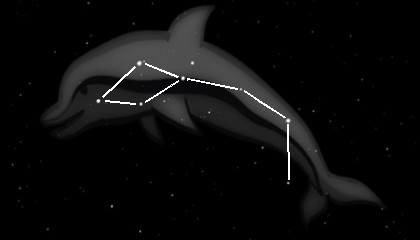 |
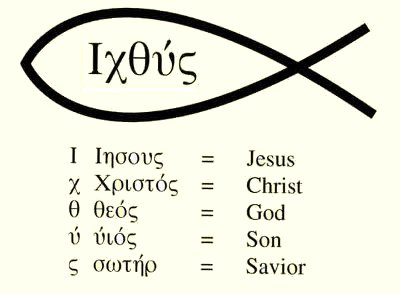 |
As for the Greek mythology about this little constellation, Eratosthenes said that it represented a messenger from the sea god Poseidon.[12] Messengers from God are what we call angels, so that is interesting in itself. The fact that it is one of the indicated seven suggests that it may be much more important than has been suspected. It is located on the telestial row of the big constellation map.
This constellation has also been interpreted to represent resurrection because dolphins are famous for jumping out of the water. Being under water can be a symbol of death, as in baptism. Many of the under water constellations represent the underworld. Thus, jumping up out of the water is an excellent symbol of resurrection. Indeed, the constellation is curved as if to show the dolphin in the act of jumping. That could also have influenced its choice by the Greeks to be the "Sacred Fish" symbolic of Christians because it was the resurrection of Christ which was a key element of Christianity.
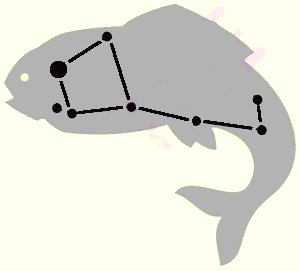 |
The Southern Fish is low in the southern sky in the watery area below the representation of the surface of the earth. It is found in the row which represents paradise, the good area in the spirit world of the dead, where there is indeed something like a church for those who have accepted Christ. Thus, it seems entirely possible that this fish represents some sort of paradise church.
Noah is associated with this constellation in two ways. First, the bright star Fomalhaut, which symbolizes Noah, is at both the head of the fish and the head of the kite pattern. Moreover, the constellation is found in the column of constellations referring to Noah. It may be that Noah actually presides over this church, especially since so many people entered the spirit world through death during the Great Deluge.
Another feature of this constellation is that the constellation of the Water Bearer (Aquarius) is just above it and is pouring water down upon the head of this fish. In fact, Fomalhaut is considered by some ancients to be both in the head of the fish and the stream of water being poured. The stream seems to represent blessing being poured out on members of the church (D&C 110:9).
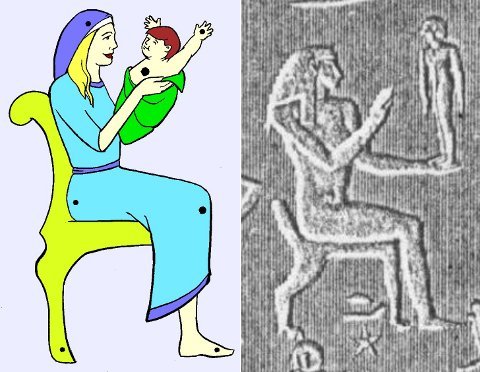 |
 |
In the spirit of knowing that these constellations were said to have been revealed to Enoch, this constellation represents Mary holding the infant Jesus. Of course it could also represent the woman in Rev. 12:5 who most likely represents the church which gives birth to the Kingdom of God, which will rule with a rod of iron. That would match the suggestion of this article that the seven figures all represent churches. If so, then that church would probably be the Millennial Church.
The only fairly bright star is found at the heart of the Infant Prince. The star is named Cor Caroli, which means the Heart of Charles, in honor of King Charles I of England. It is in what is usually recognized as the constellation Canes Venatici, which was created in the gap left by the lost constellation. It would be wonderful if that star were renamed Cor Christi.
 |
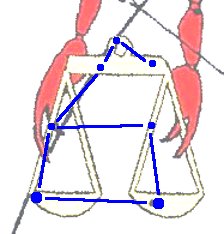 |
In my work, I have restored a picture of the balance where it is being held in the grasp of the scorpion. It has exactly seven stars, with the two bright ones in the trays. That number of stars was chosen long before the idea for this article arose. It was chosen because there are indeed seven stars in that area. The balance fits neatly between the scorpion's claws. It is composed of four stars nearly in a square and three in a row that go to the upper part of the balance. It is shown in Figure 16. Note that four of the stars are nearly on the ecliptic circle which is the apparent path of the sun, moon, and planets through the starry background.
As for any mythology associated with the Balance, there is none that I know of from Greece, as they had lost the constellation. It is said to date back to the very ancient Sumerians about 2000 BC when it was called the "Balance of Heaven". It is nearly always referred to as golden. The Romans apparently found out about it and restored it. They said it was the balance held by Astreaia, the goddess of justice.[14] Thus, this constellation, too, is associated with a female.
It has been shown that there are seven constellations each having seven principal stars which are all in the kite shape which is proposed to represent the Priesthood Pattern of Seven. A witness that these constellations are not just random is that those constellations themselves are all located in a kite-shaped super constellation. That is deemed beyond random chance and compelling evidence that these constellations were designed with this purpose in mind. The significance and deeper meanings of these 7 constellations and 49 stars is beyond the scope of this article. Here it is only desired to present this evidence as a testimony that these constellations are the product of design and testify of both the seven angels and of Jesus Christ.3. Conclusion
Notes